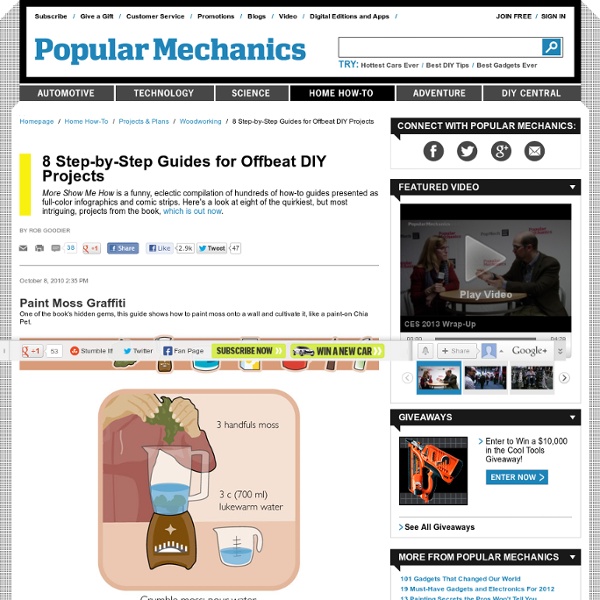



Can lid plant markers in Crafts for decorating and home decor Curious project to do along the weekend:let's recycle can lids to use them as plants marks. What do we need? Forks, used or antique Hammer Pliers Masking tape (optional) Permanent marker and a baby wipe Stamping set (you can buy it for example here) Place the lid of the can in a stable place and put a piece of masking tape to place the text perfectly in line. With the help of hammer, stamp plant name with the metal letters and remove the tape. The Idea Room: How to Make Leaf Skeletons I wanted to share with you a project from one of my readers who shares with us how to make leaf skeletons. I LOVE this! I have several leafs in various forms displayed in my home and knew I needed to make some of her leaf skeletons to add to my decor. I love how a pattern of leaves can enhance the beauty in your home.
Instructions for Finger Weaving Belts 1. Use an even number of strands (6-50), depending on the material used and the desired belt width. [Allow for contraction in loose spun yarn when it is tightly woven]. Cut strands to equal lengths. Books.Blog - Skip Graduate School, Save $32,000, Do This Instead -... Three years ago, I invested $32,000 and the better part of two years at the University of Washington for a master's degree in International Studies. The verdict? It wasn't a complete waste of time and money. Once I accepted that 80% of the course requirements were designed to keep people busy, I enjoyed the other 20% of the work. If you're strictly interested in learning, however, you may want to get a better return-on-investment than I did. Here's how to save $32,000 (or more) through your own self-directed, alternative program.Here's how to save $32,000 (or more) through your own self-directed, alternative program.
Unsimple Living Perhaps I should begin this post by introducing you to my mom, also known as Her Ladyship Craftiness…er, Her Royal Craftiness? I’m still working on the title. Regardless, she’s the coolest, most creative and talented woman I know. She can make pretty much anything. At least once during high school, I borrowed a friend’s purse, brought it home to Mom, and she whipped one up just like it for me. Yes, I probably abused the power of being Her Ladyship’s daughter, and I no longer steal my friends’ purses, but the point is: my mom is awesome. Paper mache teacup in Craft ideas for original gifts and presents It seems unbelievable that these teacups are made with paper mache! These small containers are very versatile and functional to put any detail either for gifts, wrap or decorate corners of our home. The idea starts from Ann Wood, to celebrate the 5th anniversary of her blog, which describes a great tutorial with all of the steps, including the template she used as base. The paper dialogues has made her lovely version with glitter hosting a pretty pink rose inside.
Do-it-Yourself DIY String Wedding Lanterns Yarn Chandeliers Jessica of Wednesday Inc shows us how to make those gorgeous twine chandeliers from the inspiration shoot she shared with us this morning. Using balloons, glue and twine, you can also make these lanterns for your wedding – and then bring it home and use it as your very own mid century lampshade. What you will need are: balloons, glue, yarn, tray for glue, corn starch 1/2 cup of Corn starch, 1/4 cup of Warm water, clear fast drying spray paint, hanging lamp cord or fishing line (depending on your desired final product), and a lighting kit if you’re looking for a fully functional lantern. Jessica recommends using a sharpie to mark on the inflated balloon how much room you need to leave for the lighting cord. She also recommends coating the balloon with vaseline prior to wrapping the yarn coated with glue so it doesn’t stick on the balloon once it’s dry. You can see all the details on Jessica’s blog.
THE ARCHITECTURE OF THE CLASSROOM: CHANGES AND CHALLENGES. (TULIO TIBURCIO) enhancement of teaching and learning. As stated by Bordwell, “the challenge for educators, planners and architects to integrate instructional technologies is to recognizethe magnitude of changes likely to occur over the next 25 years and to build schools that will meet these challenges.” (Crosbie, 2001).A clear understanding about the classroom environment is fundamental to understandthese changes. A good definition of learning environment is given by Wilson (1995)saying that “